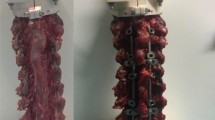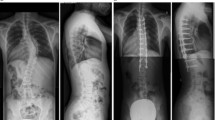Abstract
The technology used in surgery for spinal deformity has progressed rapidly in recent years. Commonly used fixation techniques may include monofilament wires, sublaminar wires and cables, and pedicle screws. Unfortunately, neurological complications can occur with all of these, compromising the patients’ health and quality of life. Recently, an alternative fixation technique using a metal clamp and polyester belt was developed to replace hooks and sublaminar wiring in scoliosis surgery. The goal of this study was to compare the pull-out strength of this new construct with sublaminar wiring, laminar hooks and pedicle screws. Forty thoracic vertebrae from five fresh frozen human thoracic spines (T5–12) were divided into five groups (8 per group), such that BMD values, pedicle diameter, and vertebral levels were equally distributed. They were then potted in polymethylmethacrylate and anchored with metal screws and polyethylene bands. One of five fixation methods was applied to the right side of the vertebra in each group: Pedicle screw, sublaminar belt with clamp, figure-8 belt with clamp, sublaminar wire, or laminar hook. Pull-out strength was then assessed using a custom jig in a servohydraulic tester. The mean failure load of the pedicle screw group was significantly larger than that of the figure-8 clamp (P = 0.001), sublaminar belt (0.0172), and sublaminar wire groups (P = 0.04) with no significant difference in pull-out strength between the latter three constructs. The most common mode of failure was the fracture of the pedicle. BMD was significantly correlated with failure load only in the figure-8 clamp and pedicle screw constructs. Only the pedicle screw had a statistically significant higher failure load than the sublaminar clamp. The sublaminar method of applying the belt and clamp device was superior to the figure-8 method. The sublaminar belt and clamp construct compared favorably to the traditional methods of sublaminar wires and laminar hooks, and should be considered as an alternative fixation device in the thoracic spine.




Similar content being viewed by others
References
Bernard TN Jr, Johnston CE 2nd, Roberts JM, Burke SW (1983) Late complications due to wire breakage in segmental spinal instrumentation. Report of two cases. J Bone Joint Surg Am 65:1339–1345
Brown CA, Lenke LG, Bridwell KH, Geideman WM, Hasan SA, Blanke K (1998) Complications of pediatric thoracolumbar and lumbar pedicle screws. Spine 23:1566–1571. doi:10.1097/00007632-199807150-00012
Doran SE, Papadopoulos SM, Miller LD (1996) Internal fixation of the spine using a braided titanium cable: clinical results and postoperative magnetic resonance imaging. Neurosurgery 38:493–496. doi:10.1097/00006123-199603000-00014 (discussion 496–497)
Faraj AA, Webb JK (1997) Early complications of spinal pedicle screw. Eur Spine J 6:324–326. doi:10.1007/BF01142678
Gaines RW Jr (2000) The use of pedicle-screw internal fixation for the operative treatment of spinal disorders. J Bone Joint Surg Am 82-A:1458–1476
Gayet LE, Pries P, Hamcha H, Clarac JP, Texereau J (2002) Biomechanical study and digital modeling of traction resistance in posterior thoracic implants. Spine 27:707–714. doi:00007632-200204010-00007 [pii]
Goll SR, Balderston RA, Stambough JL, Booth RE Jr, Cohn JC, Pickens GT (1988) Depth of intraspinal wire penetration during passage of sublaminar wires. Spine 13:503–509. doi:10.1097/00007632-198805000-00013
Hackenberg L, Link T, Liljenqvist U (2002) Axial and tangential fixation strength of pedicle screws versus hooks in the thoracic spine in relation to bone mineral density. Spine 27:937–942. doi:10.1097/00007632-200205010-00010
Hadjipavlou AG, Nicodemus CL, al-Hamdan FA, Simmons JW, Pope MH (1997) Correlation of bone equivalent mineral density to pull-out resistance of triangulated pedicle screw construct. J Spinal Disord 10:12–19. doi:10.1097/00002517-199702000-00002
Halvorson TL, Kelley LA, Thomas KA, Whitecloud TS 3rd, Cook SD (1994) Effects of bone mineral density on pedicle screw fixation. Spine 19:2415–2420. doi:10.1097/00007632-199411000-00008
Hamill CL, Lenke LG, Bridwell KH, Chapman MP, Blanke K, Baldus C (1996) The use of pedicle screw fixation to improve correction in the lumbar spine of patients with idiopathic scoliosis. Is it warranted? Spine 21:1241–1249. doi:10.1097/00007632-199605150-00020
Harrington PR (1962) Treatment of scoliosis. Correction and internal fixation by spine instrumentation. J Bone Joint Surg Am 44-A:591–610
Herndon WA, Sullivan JA, Yngve DA, Gross RH, Dreher G (1987) Segmental spinal instrumentation with sublaminar wires. A critical appraisal. J Bone Joint Surg Am 69:851–859
Ilharreborde B, Mazda K (2007) The universal clamp: a new method of thoracic fixation in the treatment of adolescent idiopathic scoliosis. Eur Musculoskeletal Rev 2:66–68
Johnston CE 2nd, Happel LT Jr, Norris R, Burke SW, King AG, Roberts JM (1986) Delayed paraplegia complicating sublaminar segmental spinal instrumentation. J Bone Joint Surg Am 68:556–563
Lei W, Wu Z (2006) Biomechanical evaluation of an expansive pedicle screw in calf vertebrae. Eur Spine J 15:321–326. doi:10.1007/s00586-004-0867-1
Lonstein JE, Denis F, Perra JH, Pinto MR, Smith MD, Winter RB (1999) Complications associated with pedicle screws. J Bone Joint Surg Am 81:1519–1528
Luque ER (1982) Segmental spinal instrumentation for correction of scoliosis. Clin Orthop Relat Res 19:2–198
Magerl FP (1984) Stabilization of the lower thoracic and lumbar spine with external skeletal fixation. Clin Orthop Relat Res 12:5–141
Moore DC, Maitra RS, Farjo LA, Graziano GP, Goldstein SA (1997) Restoration of pedicle screw fixation with an in situ setting calcium phosphate cement. Spine 22:1696–1705. doi:10.1097/00007632-199708010-00003
Nicastro JF, Hartjen CA, Traina J, Lancaster JM (1986) Intraspinal pathways taken by sublaminar wires during removal. An experimental study. J Bone Joint Surg Am 68:1206–1209
Okuyama K, Sato K, Abe E, Inaba H, Shimada Y, Murai H (1993) Stability of transpedicle screwing for the osteoporotic spine. An in vitro study of the mechanical stability. Spine 18:2240–2245. doi:10.1097/00007632-199311000-00016
Ono A, Brown MD, Latta LL, Milne EL, Holmes DC (2001) Triangulated pedicle screw construct technique and pull-out strength of conical and cylindrical screws. J Spinal Disord 14:323–329. doi:10.1097/00002517-200108000-00007
Reulen HJ, Pfaundler S, Ebeling U (1987) The lateral microsurgical approach to the “extracanalicular” lumbar disc herniation. I: A technical note. Acta Neurochir (Wien) 84:64–67. doi:10.1007/BF01456353
Rittmeister M, Leyendecker K, Kurth A, Schmitt E (1999) Cauda equina compression due to a laminar hook: a late complication of posterior instrumentation in scoliosis surgery. Eur Spine J 8:417–420. doi:90080417.586 [pii]
Schrader WC, Bethem D, Scerbin V (1988) The chronic local effects of sublaminar wires. An animal model. Spine 13:499–502. doi:10.1097/00007632-198805000-00012
Songer MN, Spencer DL, Meyer PR Jr, Jayaraman G (1991) The use of sublaminar cables to replace Luque wires. Spine 16:S418–S421. doi:10.1097/00007632-199108001-00022
Suk SI, Lee CK, Kim WJ, Chung YJ, Park YB (1995) Segmental pedicle screw fixation in the treatment of thoracic idiopathic scoliosis. Spine 20:1399–1405. doi:10.1097/00007632-199506000-00012
Wilber RG, Thompson GH, Shaffer JW, Brown RH, Nash CL Jr (1984) Postoperative neurological deficits in segmental spinal instrumentation. A study using spinal cord monitoring. J Bone Joint Surg Am 66:1178–1187
Acknowledgment
The biomechanical testing described in this study was funded by a contract with Abbott Spine Cite’ Mondiale, France.
Author information
Authors and Affiliations
Corresponding author
Additional information
All work performed at Mayo Clinic Rochester.
Rights and permissions
About this article
Cite this article
Hongo, M., Ilharreborde, B., Gay, R.E. et al. Biomechanical evaluation of a new fixation device for the thoracic spine. Eur Spine J 18, 1213–1219 (2009). https://doi.org/10.1007/s00586-009-0999-4
Received:
Revised:
Accepted:
Published:
Issue Date:
DOI: https://doi.org/10.1007/s00586-009-0999-4




